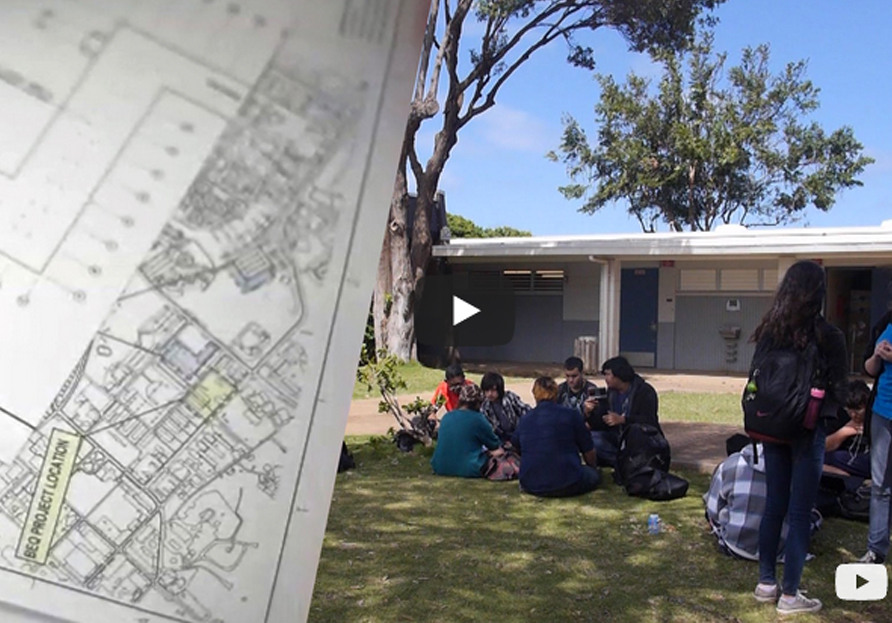JUDY WOODRUFF: Now we travel to the island of Maui in Hawaii, where multi-building schools are designed to withstand natural forces, but protecting against intruders is still a challenge.
Student Television Network correspondent Sydney Dempsey looks at how one architect is reimagining spaces that balance security with a healthy learning environment.
It’s part of our ongoing Student Reporting Labs series called The New Safe, in which student journalists investigate how school communities are adjusting to new concepts of safety in the classroom.
MIKAYLEE CHALMERS, Maui High School student: Well, when I first came here, I thought it was really big. And, like, I even had to use a map to try and find my way around. And I think I’m still using it today, like, just to check and make sure I know where I’m going.
SYDNEY DEMPSEY: Mikaylee Chalmers, a Maui High sophomore, has had her fair share of campuses, but after seven schools and five states, something about Hawaii still stands out.
MIKAYLEE CHALMERS: It’s nice to be outdoors and get some fresh air.
CHARLES KANESHIRO, President, Group 70 International Inc.: Yes, Hawaii is a unique environment, in that, I think as all of us here who live here know, we have a climate that is pretty much comfortable year-round.
SYDNEY DEMPSEY: But over the years, Charles Kaneshiro, the president of an international architecture firm based in Honolulu, sees a storm brewing in his industry.
CHARLES KANESHIRO: The majority of our schools in Hawaii are older, so they’re designed to standards that existed 50 years ago. The more current schools are being designed with school safety in mind. And obviously that’s because of, you know, Columbine, and, more recently, Sandy Hook.
I don’t think anybody 20 years ago would have even imagined, you know, something like that happening in a public school. I mean, we send our kids to go to school to learn, not to be killed.
SYDNEY DEMPSEY: Alconcel has worked as a school resource officer for three years. He says he has noticed that with the rising risk of school violence, there are inherent challenges with protecting schools with multiple buildings.
TRINIDAD ALCONCEL, School Resource Officer, Maui High School: Trespassers can gain access to our campus 360 degrees, making it nearly impossible for us to maintain a secure campus, unless we had the manpower to hold hand by hand and surround the school. It’s pretty much impossible to keep somebody out.
CHARLES KANESHIRO: There’s all this fear now that I may send my son or daughter to school and they may not come home. And so there is a tendency to want the schools to become a prison. And that’s the tradeoff. You know, if we design our schools as prisons, then can you imagine the type of education that’s going to occur in them?
TOBY NEAL: If there was bars displayed, metal detectors that they have to go through, there’s this constant unsettled feeling. All of that creates a culture of anxiety and hypervigilance, which, when you’re in a hypervigilant state, which is watching out for danger, you can’t — it’s really hard to learn.
SYDNEY DEMPSEY: Toby Neal, a licensed clinical social worker at Maui center for child development and a previous counselor at multiple Hawaii schools, suspects that fear-driven architecture may detach children from their roots.
TOBY NEAL: We didn’t evolve inside of buildings. And I think the optimal learning environment includes nature.
CHARLES KANESHIRO: In order to balance the two, a good learning environment and a safe area, is by having what we call zones of supervision. So, instead of less glass, there’s actually more glass.
SYDNEY DEMPSEY: Pu’u Kukui Elementary School features large hurricane windows, which can hold form even when cracked at impact, open areas within immediate distance of protected spaces, unobtrusive chain-link gates, which subtly control axis points, a campus-wide alert system, and staff distributed so that every corner of campus is under adult supervision at all times.
CHARLES KANESHIRO: It’s not about designing a completely tragic-proof school. We can’t do that. And that would be a prison.
SYDNEY DEMPSEY: Ultimately, it’s about balancing security with nurturing learning environments, so students like Mikaylee can enjoy what makes school school. She believes children should be able to:
MIKAYLEE CHALMERS: Come to school and just focus on their work and seeing their friends and not have to worry about, like, their well-being or anything.
